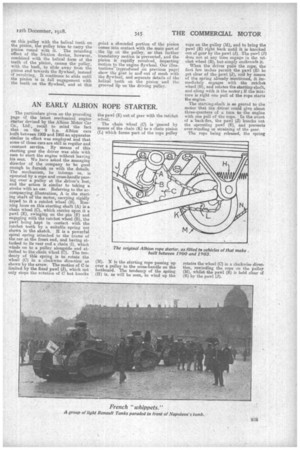AN EARLY ALBION ROPE STARTER.
Page 15

If you've noticed an error in this article please click here to report it so we can fix it.
The particulars given on the preceding page of the latest mechanical engine starter devised by the Albion Motor Car Co., Ltd., recall to mind the fact that on the 8 h.p. Albion cars built between 19C0 and 1903 an apparatus similar in effect was employed and that some of these cars are still in regular and constant service. By means of this starting gear the driver was able with ease to start the engine without leaving his seat. We have asked the managing director of the company to be goad enough to furnish us with the details. The mechanism, he informs us, is operated by a rope and cross-handle passing over a pulley at the driver's feet, and the action is similar to taking a stroke with an oar. Referring to the accompanying illustration, A is the starting shaft of the motor, tarrying rigidly keyed to it a ratchet wheel (B). Running loose on this starting shaft (A) is a chain wheel (C), which carries upon it a pawl (E), swinging on the pin (F) and engaging with the ratchet wheel (B), the pawl being kept in contact with the ratchet teeth by a suitable spring not shown in the sketch. H is a powerful spiral spring attached to the frame of the car at the front end, and having attached to its rear end a chain (I), which winds on to a pulley alongside and attached to the chain wheel (C). The tendency of this spring is to rotate the wheel (C) in a clockwise direction as shown by the arrow. The motion of C is limited by the fixed pawl (.1), which not only stops the rotation of C but knocks
the pawl (E) out of gear with the ratchet wheel.
The chain wheel (C) is geared by means of the chain (K) to a chain pinion (L) which forms part of the rope pulley (M). N is the starting rope passing up over a puller to the cross-handle on the footboard. fhe tendency of the spring (II) is, as will be seen, to wind up the
rope on the pulley (M), and to bring the pawl (E) right back until it is knocked out of gear by the pawl (J). The pawl (.1) does not at any time engage in the ratchet wheel (B), but simply enshrouds it. When the driver pulls the rope', the first few inches permit the pawl (El to get clear of the pawl (J), and by means of the spring already mentioned, it immediately engages with the ratchet wheel (B), and rotates the starting-shaft, and along with it the motor ; if the mixture is right one pull of the rope starts the engine. The starting-shaft is so geared to the motor that the driver could give about three-quarters of a turn to the engine with one pull of the rope. In the event of a back-fire, the pawl (.1) knocks out the operating pawl. (E), and prevents over-winding or straining of the gear.
The rope being released, the spring rotates the wheel (C) in a clockwise direction, rewinding the rope on the pulley (M), whilst the pawl (E) is held clear of (B) by the pawl (J).






















